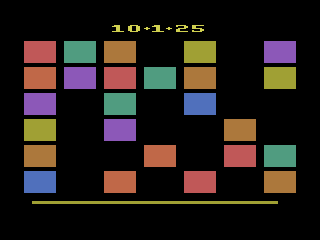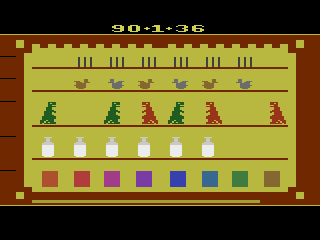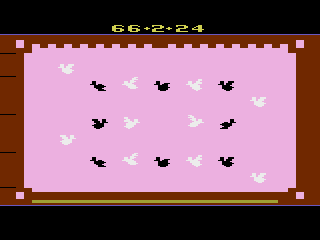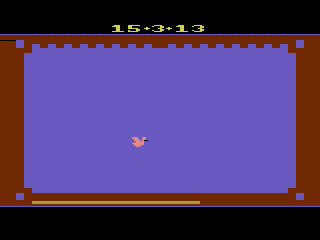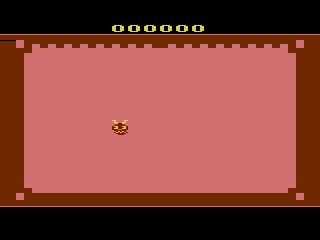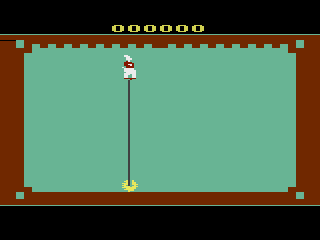|
|
Shooting Arcade
|
Name:
|
Shooting Arcade |
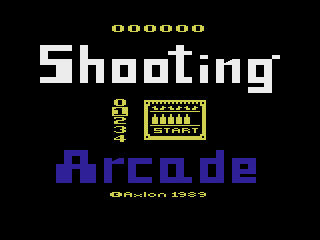 |
| Company: | Atari | |
|
Model #:
|
CX-26169 | |
|
Programmer:
|
Agustin Ortiz (Heuristica) & Tod
Frye (Atari) |
|
| Year: | 1989 | |
|
Released?
|
No
|
|
|
Notes:
|
One of only two 2600 games to use the light gun. |
Shooting Arcade is one of only two 2600 games to use the light
gun (Sentinel was the other), but was never released. This
is a shame because Shooting Arcade is a creative light gun
target game similar to the Point Blank series, and would have
been unique among 2600 games. Interestingly it appears
that Shooting Arcade was not developed in the US, but rather in
Mexico by a company called Heuristica. How Axlon was
invovled is unknown, but they may have simply sub-contracted the
game out to Heuristica instead of doing it themselves. It
then appears that either Axlon or Atari decided to contact
veteran programmer Tod Frye to make some final tweaks to game.
Shooting Arcade is really made up of six different scenes that are put together in different orders depending on the level you've selected. Each scene has its own unique theme, rules, and objective, making Shooting Arcade essentially six games in one. Depending on which skill level you choose, the scene's attributes change to make it more or less difficult and the timer at the bottom of the screen counts down more or less quickly. The status bar at the top of the screen shows the number of shots you have left, your current difficulty level, and the number of targets left. You start each level out with a limited amount of ammunition depending on the difficulty level (40, 10, 5, 2, or 1). You can continue from the last screen you completed an infinite amount of times by simply pressing the reset button. This is a handy feature as the game get very hard at the later levels...
The six scenes are:
Colored Squares - Here you must shoot out all the colored squares before the timer runs out. Starting on level 1 if you shoot and empty area where a square would be, a new square appear and you'll have to shoot it again! On level 4 the squares will all disappear after you take your first shot, and you must memorize where all the squares were before you start. The squares can briefly be seen when you take a shot which helps a bit, but they will reappear if you shoot the same area twice (as in level 1). Every square you successfully hit will give you two extra shots.
Shooting Gallery - This scene is reminiscent of Imagic's Shooting Gallery cartridge. Here you must shoot various carnival targets such as glass pipes, ducks, milk jugs, colored squares, and dinosaurs? The targets in the center area move at a fair clip (depending on the difficulty level) and the pipes at the top can be very difficult to hit making this scene one of the toughest in the game. Speaking of squares, you can shoot the colored squares at the bottom of the screen to gain extra ammo if you're in need. To clear this scene you must successfully shoot all the targets.
The Birds - This scene is only accessible from level 2 onward. In this scene you must shoot all the black and white birds before the timer runs out. The birds move with a up and down motion, but follow a specific path around the screen so you can predict where they will move. The background will change from black to white during the course of the scene effectively camouflaging the birds making them even more difficult to hit.
Target Practice - This scene is one of the hardest to complete, since you begin with almost no ammo and the timer counts down lightning fast. The concept of this scene is quite simple, you must shoot the various birds which fly around the screen. Unlike the previous scene, these birds only appear one at a time and they move very very fast. The birds will wrap around from one side of the screen to the other, so you can try and anticipate where it will appear next. This scene is only accessible from level 3 onward.
The Demon - This scene is damn tough! You must shoot a demon who randomly teleports around the screen. Since this scene is only accessible on skill level 4 you start low on ammo and have almost no time. If you shoot the demon enough times you will move onto the final scene.
The Unicycle - This is the final scene in the game. Here you must shoot the unicycle out from underneath a poor clown and watch him fall to his death (ok so I made the last part up). Every time you shoot the unicycle, the clown will lower a bit until he's just sitting on the wheel. Since the unicycle is very thin and moves at a surprisingly fast clip, this scene is nearly impossible to beat. The clown will go back and forth three times, and then it's game over. Likewise, if you shoot the clown it is an instant game over (but oh so satisfying). Shooting the wheel will only make the clown change directions, speeding up his eventual departure. Like the demon scene, this scene is only accessible on level 4.
So why wasn't shooting arcade released? No one knows the true reason, but one possibility is the horrid controls. The light gun aim is so off it makes it almost impossible to hit something by aiming directly at it. If your lucky enough to actually hit something, it's almost a guarantee that you'll never be able to hit it again as the shooting code is so buggy that shooting at the same spot three times in a row will result in hitting three completely different areas of the screen. Even the tried and true cheating method of having the gun right up against the screen won't fix the issue. This problem is really the death nail for Shooting Arcade, and ruins what could have otherwise been an awesome game. Another possibility is the late date of the game (1989), by 1989 Nintendo was all but king, dominating everything in sight. It's doubtful that an Atari 2600 target shooting game would have sold in great numbers, and is probably why Atari went with the more action oriented light gun game Sentinel.
If you can get over the flawed targeting system, Shooting Arcade can be really fun. It's interesting to see just how much programmers could squeeze out of the ancient 2600. A game like this really pushed the poor old 2600 to its limits, and proves that a good programmer can do wonders even on bad hardware. Don't think of it as Shooting Arcade, think of it as Point Blank 0.5.
| Version | Cart Text | Description |
| 3/7/89 | Beta compiled from source code | |
| 9/18/89 |
Shooting Arcd C300024-169A NTSC 9/18/5 |
Final Version |
| 1/16/90 |
Shooting Arcd C300046-169A PAL 1/16/90 |
Final Version (PAL) |

